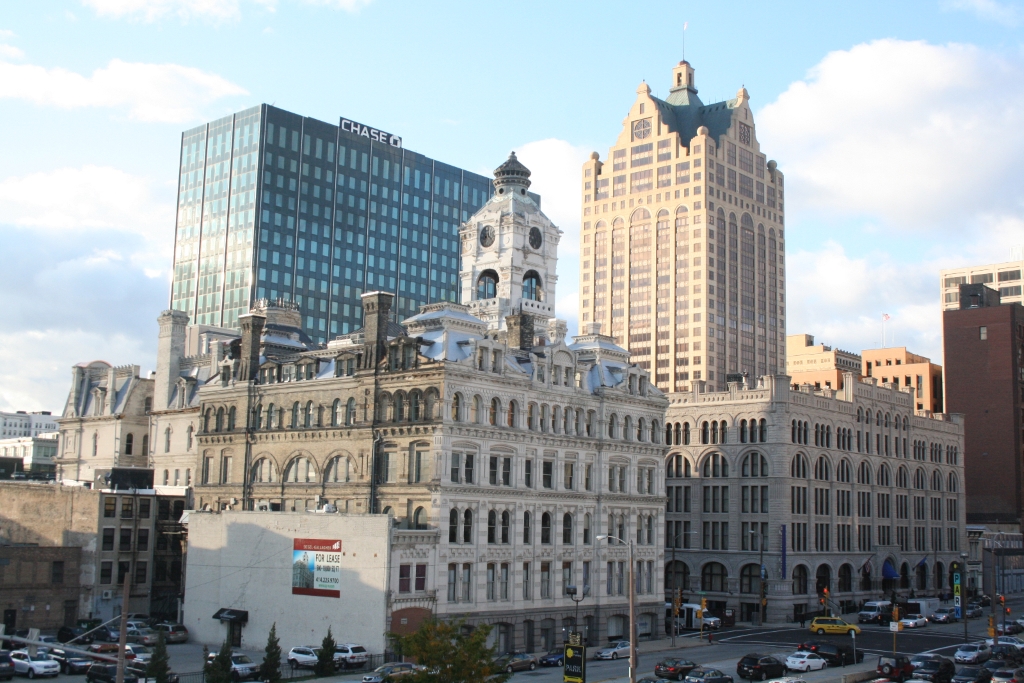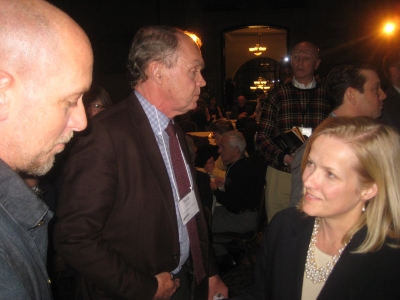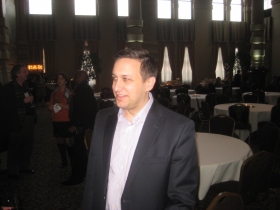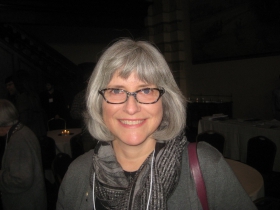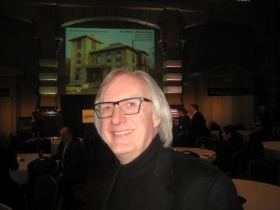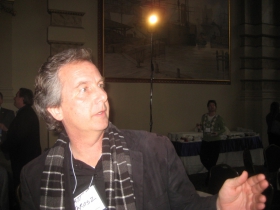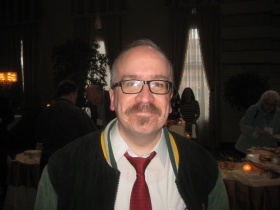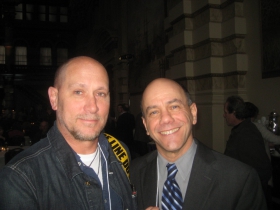In Defense of Historic Tax Credits
National Trust for Historic Preservation's leader comes to town, where her speech to a crowd filled with notables dramatized the need for state to maintain the current credits.
Last week, Stephanie Meeks, the President and Chief Executive Officer of the National Trust for Historic Preservation came to town to deliver a speech at an event entitled, “Older Buildings — Livable Cities,” held Thursday at the Grain Exchange Room in the 1879 Chamber of Commerce Building (the Mackie Building). The preservation of historic buildings is helping to make Milwaukee a “hot spot” attracting more adults under 35 than any Great Lakes city, Meeks noted. In attendance for the speech was a crowd filled with city notables, where the consensus was that Meeks’ call for maintaining the current level state historic tax credits was essential to the progress of both Milwaukee and the entire state.
The state historic tax credit is designed to promote existing building rehabilitation and reuse for commercial purposes, and is usually coupled with the Reagan-era Federal Historic Tax Credit Program that also offers a 20 percent credit for “income-earning, privately owned buildings.”
In 2014, the state raised its credit to 20 percent from 5 percent, and eliminated a cap on credits issued, “and that changed everything,” according to Matt Jarosz, Associate Adjunct Professor at UW-Milwaukee’s School of Architecture and Urban Planning and chair of the university’s Historic Preservation Institute. In his remarks at the event, Jarosz cited 31 projects now underway in the state that are using $35,071,257 in credits to leverage some $211 million in redevelopment. Credits in 2014 ranged from the $10,000 awarded to the O’Kroley Building in Madison to the $4,360,000 awarded to the Posner Building renovation now underway in downtown Milwaukee.
But the proposed modifications would jeopardize future redevelopment, Jarosz said, by:
- Restricting credits to “certified” building rehabs
- Limiting total credits to $10 million
- Awarding credits on a competitive basis
He called for the retention of the existing program, which would likely require a veto-proof majority of the Republican-dominated legislature. His theme was taken up and dramatized by the evening’s featured speaker, Meeks, who told the 250 people in attendance she “likes Milwaukee,” and that this was her fourth visit to the city in five years. Milwaukee, she noted, is participating in the national trend toward urban living. “I hope that Wisconsin will continue to fund the program,” as these tax credits “are the most important tool in the arsenal” in the transformation of cities. But Governor Scott Walker‘s budget “looks at the credits as an expense, rather than a revenue generator,” she noted.
The credits “reduce corporate income / franchise tax collections,” on the front end, according to the Legislative Fiscal Bureau. But these amounts are usually recovered within 3 years of a project’s completion, according to a preliminary progress report by the UWM Historic Preservation Institute dated March 8th, 2015 and distributed at the event.
Furthermore, the study notes, tax revenue generated from “the jobs and construction investments is immediate.” The 2014 expansion of Wisconsin credits moved the state from last in the Midwest to first place in “most economic and job creation categories related to Historic Tax Credits.” Figures cited show that the credits provide an immediate 25 percent return based on these metrics.
Meeks, in her comments, pointed out that 60 percent of Wisconsin’s $211 million in HTC projects, including the Posner Building, were vacant at the time of construction. As the study notes, “An active, fully reused historic building will generate far more property taxes than an abandoned or lightly used structure. The revenue flow is crucial to local governments throughout Wisconsin.”
Rehabilitated older buildings often serve as a core for redevelopment of non-conforming buildings or vacant lots ineligible for credits in historic areas like the Historic Third Ward, spreading the economic benefit.
This comes at a time when demand is greatly increasing for reuse of older buildings in city centers. “We can move cities forward” with the credits, Meeks said in her remarks. “Cities are making a comeback. For the first time in history there are more urban residents than not. … The people flocking to cities are disproportionately younger, and their numbers grew by 40 percent in 15 years,” she added.
There was a 75 percent increase — or 3,800 individuals — among the population of residents aged 20-34 during that time on the East Side of Milwaukee, she said. These new residents are “attracted by historic buildings,” she said, and have helped Milwaukee to grow “faster than any other Great Lakes city, including Chicago. … Places that were not hot spots even 3 years ago are very vital today.” (In Milwaukee, the Walker’s Point neighborhood seems to fit in that category.) The rehabilitation of old buildings draws people to neighborhoods that are more walkable, creates more new jobs, draws more women and minorities and produces more new businesses than other real estate development, Meeks said.
How does she know that?
“We tracked cell phone records,” she said. “And you thought only the NSA was tracking your phone!”
“Older buildings provide spaces for entrepreneurs,” Meeks said. The New Market district in San Francisco is still in transition, but drew such innovative firms as Twitter, Spotify and Dolby, “because their employees like to work in old buildings.”
“Preservation is about keeping buildings in active use, and keeping historic neighborhoods alive and continuing to grow” with the “younger people who will be our economic engine moving forward,” she concluded.
So much for the policy — now for the politics.
At least one Republican member of the legislature will press his colleagues to continue the program. Andre Jacque, the representative of the Assembly’s 2nd District, was once a grant writer for the City of Green Bay with an responsibility for redevelopment issues. Too often, he said, “people couldn’t find gap financing” to make projects feasible. The HTC program, he said, was “a driver” that spurred the redevelopment efforts. “I’m optimistic we can have the credit restored,” he said.
He was joined on the panel by Jim Draeger, the State of Wisconsin Historic Preservation Officer, who said it was a “myth” that “Historic Preservation is anti-development, and anti-progress.”
In fact, he said, “Historic Preservation is economic development. Without economic development, we can’t preserve historic properties.
“Historic Preservation intervenes in the life cycle of declining buildings,” he said. We can bring life back to cities “by bringing life to these buildings.”
“If you’re cutting a program, don’t cut the one that’s making money,” he concluded.
Panelist Joshua Jeffers brought a developer’s perspective to the forum. He is the landlord of the Chamber of Commerce Building, where the event was held in the magnificent Grain Exchange room, itself a product of a historic redevelopment. The room, painted in florid 19th century style with murals and allegories galore, had been obscured for decades by a ceiling that had hidden the top 42 feet of the room’s height. “It was a building ‘modernization’ gone terribly wrong,” he said, and was partially reclaimed by a previous owner. But most of the building, with the exception of the occasionally used Grain Exchange Room and the long-running Swingin’ Door Exchange tavern and restaurant, on the ground floor, is vacant.
Jeffers proposes converting the mostly vacant office space in the remainder of the building into 25 apartments, he said, and HTC financing is critical. That’s because renovation of old buildings is always more expensive than new construction.
“There are many defects” in the Belle-Epoque structure designed by Edward Townsend Mix for his patron, Alexander Mitchell, whose eponymous building next door Jeffers has already remodeled, he said.
“For whatever reason, the groundwater beneath the building is sinking,” exposing the top portion of its wood piling foundation to rot. Each of the building’s 1,000 or so pilings must be individually stabilized, one at a time, as was done next door. You don’t have that kind of expense with a new building, nor can you sensibly remodel a building that lacks a stable foundation.
“The clock tower has problems. The roof leaks. We are missing a required exit. It’s functionally obsolete,” Jeffers said of his pride and joy.
He couldn’t “core through the Grain Exchange room” to solve the building’s problems, which seemed insurmountable.
“But in January, 2014, I was reading about tax credits and I realized the economics would work,” he said. As a result, he said, he will be able to put a $12 million investment into a building that is now 90 percent vacant and only assessed at $625,000. It is one of the six sources of capital required for the project.
Jeffers said “there are people in the legislature who don’t understand how tax credits work. To set the record straight I will still pay property taxes on this building” … at a rate based on a $12 million assessment, not a $625,000 assessment, he pointed out.
“Could we make this project work without tax credits? he asked.
“The answer is absolutely ‘no.’
“We will break ground in July. … And for the record, the Swingin’ Door is staying.”
About the Event
The “Older Buildings Livable Cities” program was the fourth of ten of a planned 5-year Historic Preservation Lectures Series presented jointly by the UWM Historic Preservation Institute and the Milwaukee Preservation Alliance. “The symposium brings together professionals from all areas of historic preservation with the intention of creating cooperative strategies for future heritage preservation in Milwaukee,” according to its prospectus.
The National Trust was chartered by Congress in 1949, and has been a privately-funded non-profit corporation since the 1970s. The trust’s role has evolved over the years from a focus of creating house museums like Woodlawn Plantation into a dynamic force in urban redevelopment. As President Meeks said in an earlier address, house museums are not the only answer to preserving historic old residences. Sometimes the best use of an old house is as a private home, and the trust has worked along those lines in recent years as it has shifted its focus to sustainable private redevelopment.
Mike Hatch, the real estate lawyer who is key to many development plans, sat at a front-and-center table with architect, real estate investor and developer David V. Uihlein, Jr.
Uihlein is a major player indeed, who owns and has considerably enhanced the historic McGeogh Building on Milwaukee St. where his Uihlein Wilson architecture firm is located. It specializes in historic buildings like Turner Hall and the Charles Allis Museum. Uihlein also owns a lot south of the Chamber of Commerce Building that will be incorporated into Jeffers’ building plans, and his support of Historic Tax Credits may help to sway the legislature into supporting their retention in the current form.
Uihlein is also a trustee of the Lynde and Harry Bradley Foundation, named after his grandfather and uncle. This conservative foundation may find tax credits and historic preservation to be appealing. Its location is in a historic complex of three buildings in Yankee Hill, one of which, the Bloodgood House, is being remodeled by Uihlein’s firm at this time. Perhaps Uihlein could suggest that his fellow foundation trustees commission a study of the value of historic tax credits, and then distribute a copy to each Republican legislator. Bradley-sponsored studies have swayed the legislature in the past, and its president Michael Grebe is a close adviser to Governor Walker.
Correction: An earlier version of this story indicated that Quorum Architects was using tax credits to redevelop the remaining vacant buildings on Milwaukee’s Historic Third Ward’s “Commission Row.” This was incorrect, Continuum Architects is the firm involved in redeveloping the buildings.
Photos from the Event
Plenty of Horne
-
Villa Terrace Will Host 100 Events For 100th Anniversary, Charts Vision For Future
 Apr 6th, 2024 by Michael Horne
Apr 6th, 2024 by Michael Horne
-
Notables Attend City Birthday Party
 Jan 27th, 2024 by Michael Horne
Jan 27th, 2024 by Michael Horne
-
Will There Be a City Attorney Race?
 Nov 21st, 2023 by Michael Horne
Nov 21st, 2023 by Michael Horne


